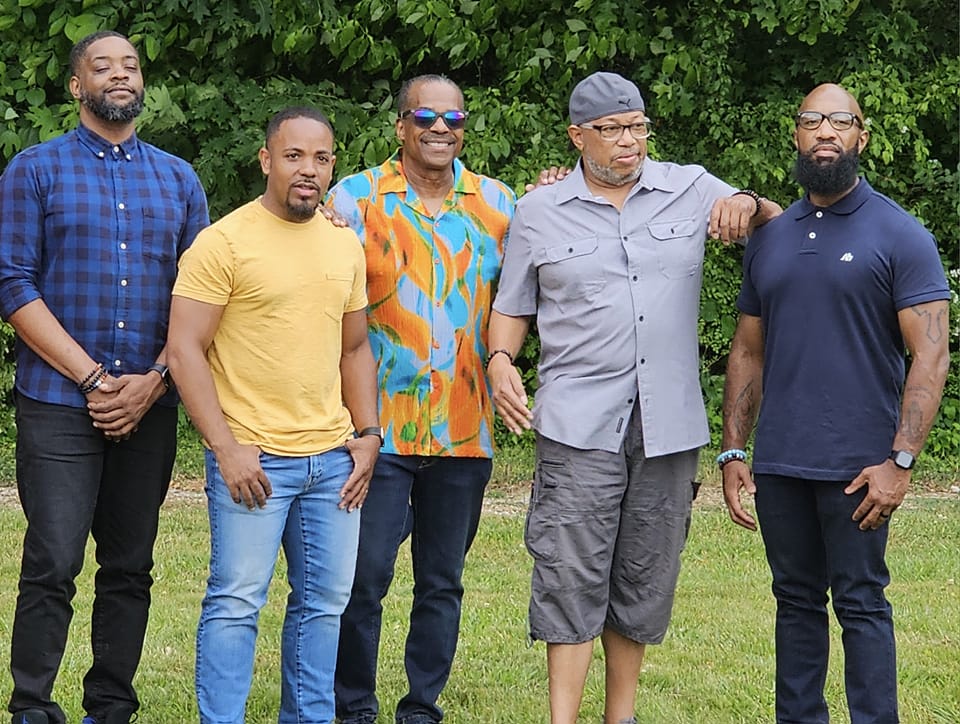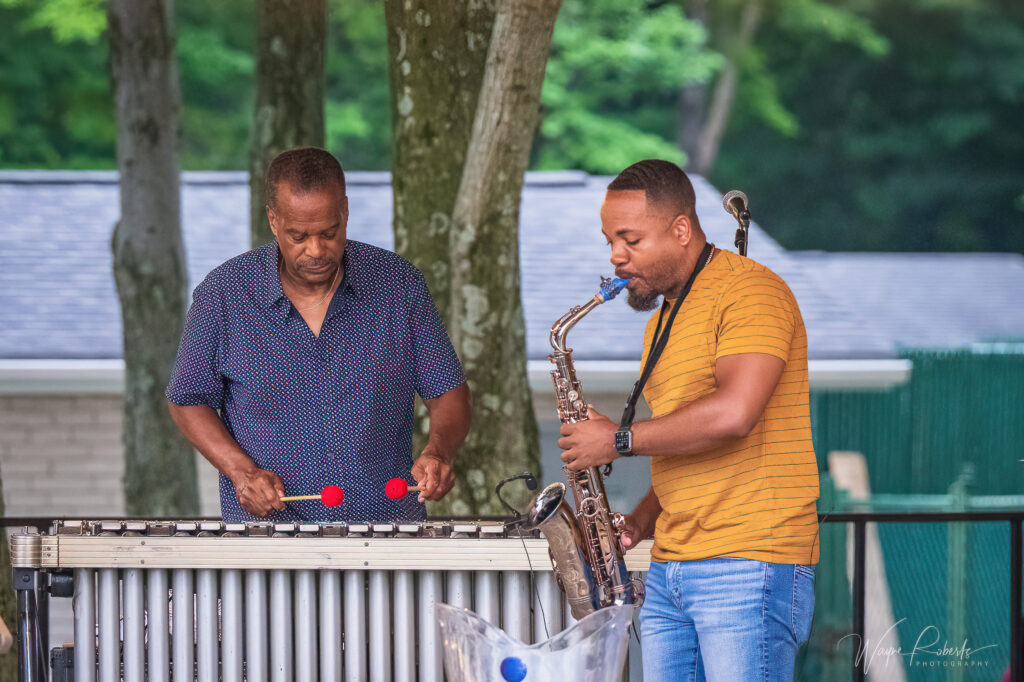For many children, the lure of learning to play an instrument occurs early. Some instrument catches their eye, their heart, and their imagination, and that then becomes an integral part of their life. Sometimes it turns out to be a passing fancy, other times a lifelong career. But for Lem Adams, he was a late bloomer. It wasn’t until he was around thirty years of age that an extraordinary instrument caught his interest — and he’s been “vibing” ever since.
Vibraphones — vibes — aren’t usually what you first land on when you think of musical instruments. Piano, strings, horns, woodwinds, percussion — that’s what comes to mind. But vibraphones? Does anyone still play vibraphones? They do and Lem has become a local legend playing vibes in the band “Forecast” since 1980, as well as playing for greats like Earl Klugh, The Crusaders, Stanley Turrentine, Bob Newhart, Roy Ayers, Grover Washington Jr., and many more.
Vibes, invented in 1916, have a unique sound all their own. It became a favorite of jazz orchestras and was even used in classical compositions to add a contemporary jazz flair. Weighing up to 250 pounds, it’s not the easiest to transport and also not the easiest of instruments to learn to play.
When Lem discovered the vibraphone on display in a piano store window on Euclid Ave., he was working in a factory at the time. He didn’t play any instrument of any kind, didn’t even read music. But he’d grown up in a house where his dad played jazz all the time, especially singers. All the jazz greats seeped into Lem’s consciousness, a genre he grew to love.

Gary Stevenson – bass, Alphonso McDuffie – keyboards
After purchasing the vibraphone in the store window, the hard work began. Lem was able to get a little training in the instrument but for the most part, he’s self-taught. Very important for a musician, he listens and what he hears, he picks out the vibes. He also listened to the great jazz vibraphonists and studied their techniques and styles. His favorite was Roy Ayers from whom he learned an important lesson.
“I was playing with Roy one day and he pulled me aside and said, ‘You’re doing great man, but I noticed that you sound a bit like me. Do yourself.’ What a wake-up call. I was so used to copying other musicians, that I’d entirely forgotten about myself in the equation.”
So now, Lem had to figure out who he was as a musician. “I’d listen to these guys and grab a lick from this record and a lick from someone else’s record. And then I had to come up and create a feeling of my own.” In that process, Lem eventually let his heart and Soul come through his playing. And Soul is what music is all about to Lem.
“You want to feel the Soul in someone’s playing. But with all of this technology today, you just hit a button and it produces and repeats something perfectly. But it’s not human — there’s no Soul, no authenticity. It used to be that you’d lay a lot of tracks and then you’d piece things together to truly bring it to life. With technology, that’s all going away.”
For Lem, music is a journey, whether you’re in the studio composing and trying things out or sitting in an audience soaking up the vibes. “I’m always listening when I’m performing. I’m also learning, something I’m going to keep doing for the rest of my life. I’m always trying to do something different, to change things, make it better — but without repeating myself. That way, I’m staying fresh and there’s nothing manufactured about my work or performing.”
Lem looks back on some of his early recordings and how he used to play compared to how he plays today. “At times, I sound the same, but I can see how I’ve gotten a little better. There’s always room for improvement. I’m never happy with my playing and because of that, I’m never going to stop trying. I’m going to keep moving on. And audiences pick up on that because your playing is immediate. You want to be in the groove, to be able to touch people. That’s being real, being authentic.”
That process and goal keep Lem continuously striving to expand on his work, and to reach his audience in ways that take them along on his journey. One aspect of that journey involves the comings and goings of band members.

“We’ve had quite a few people join and then eventually leave Forecast for all sorts of reasons. The band has changed a lot, but we’re still gigging. Even though it’s become tough in Cleveland what with all the competition out there, we’re still playing all over. We’ve been playing more and more festivals and more outdoor venues. Our summers have been great for years.”
But Lem knows how to shift with change whether it’s band members rotating in and out or just how the processes of life creep up on you. The life of a musician often means long nights of playing gigs into the early hours, but now Forecast finishes up by 9 pm. “It’s where life is these days — and taking power naps before a gig works wonders. It’s funny … by the end of an evening, younger players who are completely beaten are wondering how I still have energy. Naps!”
And then there’s the fact that one of the things that keeps Lem going is the fact that he’s now ten years cancer-free. He is always advocating for people to get their yearly checkups. He was lucky in that his cancer was caught in the very early stages so that he didn’t need to have his prostate removed or deal with chemo — all because he keeps to a yearly checkup schedule. Now, every day is another day of moving forward, diving into his music, and speaking up to younger people and musicians.
Speaking of younger musicians, Lem is very inclusive when it comes to artists who are just starting. He remembers how he was treated when he attended a jam session with a well-known musician by the name of Otis. At the time, Lem only knew one piece, so wasn’t able to fit in with the other musicians. The venue where the jam session was being held was packed with audience members.
Otis, upon finding out from Lem that he knew only the one piece, had never attended a jam session before, and had never had lessons, embarrassed Lem in front of the entire audience by pointing all of this out to them over the mic — at length. A hard lesson for Lem about musicians and the industry, but one in which he learned how important it is to encourage and support other upcoming artists.
“I tell young people to just get out there and create. You never know who will be listening. Whatever you’re producing, that’s you and no one else. Be original because, as the saying goes, everyone else is taken.”
The other thing Lem tells young musicians is to learn to play multiple instruments. “That’s the name of the game these days. Learn to play two, three, or more instruments. Not only will you get more work that way, you’ll also earn the respect of other musicians and those in the industry. It makes you adaptable, expands your range, and you become marketable.”
How this works musically is that by learning several instruments, a musician can communicate more effectively with the bass player, the drummer, and the keyboardist. They’ll know more intrinsically what their fellow bandmates are about and the ‘why’ behind their playing. Lem says, “Learn several instruments and you’ll go much farther in the industry.”
He points out that a lot of great musicians, though people didn’t initially catch on to their style and composition, remained true to their vision and how they wanted to express themselves in the world. Now we look back and marvel at what they gave us musically, their viewpoint, and their genius. And that may be one of the most challenging aspects of being a musician in today’s world of innumerable distractions, wannabes, and imitators.
“Center on being yourself and don’t lose your drive to create. Music isn’t limited and neither are you. Take what has come before you, learn from it, and then be an original masterpiece!”


